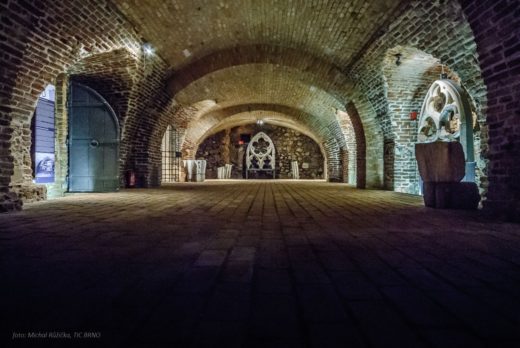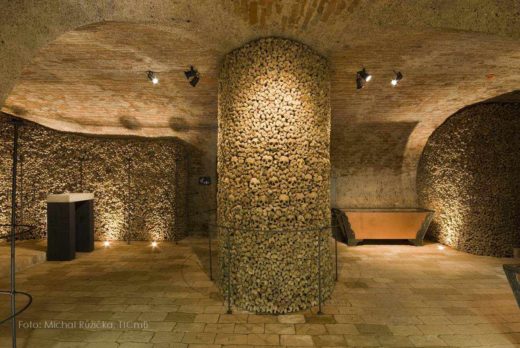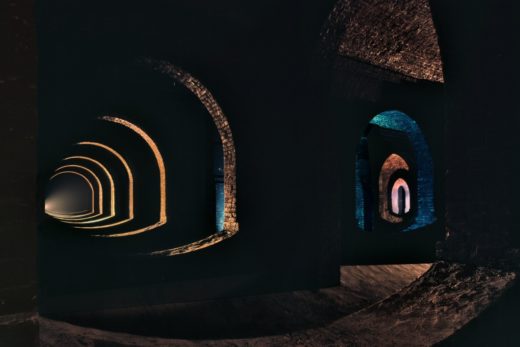High temperatures make most people seek relief in swimming pools, lakes, seas and rivers. But what about the people who can’t swim or those who get sunburnt easily, for example? Well, those non-swimmers and all people who’d like to avoid sunlight can always hide in the underground places in Brno! It’s nice, dark and cool there – perfect places to visit during hot summers when the city feels like a frying pan.
Underground – the Hyde to Brno’s Jekyll
Brno is unique among Czech cities in one way – the extensive network of underground corridors, tunnels, crypts and cellars. They weren’t always open to the public – the city of Brno has only recently started to gradually open them to curious visitors. Currently, there are only six underground spaces that you can visit, which is already a lot, but there are even more places waiting to be open!
The Mintmaster’s Cellar
The Mintmaster’s Cellar was discovered in 1999 and these were the first six underground spaces of Brno that were opened to the public on November 26, 2010. The whole area is located mainly under the building of the New City Hall – the former seat of the state administration in Moravia. The vault of the original historical cellar of the Mintmaster’s House lies only 60 cm below the paving of the Dominican Square. The cellar served the Royal Mintmaster as a warehouse of raw materials and new coins before they were put into circulation. That means that minting of the coins itself took place in other places in Brno, but not directly in the cellar.
Don’t think it’s just an empty cellar which you’d visit and say “well, that was ‘meh’” – there are seven rooms with interesting installations and exhibitions dedicated to coinage craft and the history of the area. In the Mintmaster’s Cellar you can also find preserved fragments of the Royal Chapel, which was demolished in 1908.

The Labyrinth under the Green Market
Almost one year after the Mintmaster’s Cellar the Labyrinth under the Green Market (Zelný trh in Czech) was opened to the public in April 2011. The Green Market is one of the oldest preserved squares in the whole of Brno and it was first mentioned at the beginning of the 13th century when it was called Horní trh (Upper Market). Today’s name comes from the 15th century. Surely you’ve already visited the market yourself so let’s now pay attention to the labyrinth that is hidden beneath. The local cellars were built under individual houses from the Middle Ages to the Modern Age, but most of them were built during the Baroque period. They were used mainly for storing food, maturing beer and wine in barrels, and as wartime shelters. Originally, the cellars were not interconnected as they are now – that happened later during the reconstruction in 2009.
In the tourist part of the labyrinth, the visitor can observe with their own eyes how the cellars were used at the time of their creation. They will, for example, learn how food was stored before cellars were replaced by refrigerators and get acquainted with the development of lighting fixtures used in the underground. The exhibition is complemented by daily necessities found during archaeological excavations of the Green Market. Basically, you’ll travel in time without actually going anywhere, which means you don’t have to worry about wars, plague and other “nice” things from the past. Although the truth is that you can see a replica of a Medieval pillory there too.
The Ossuary under the St. James Church
One of the most significant and most important places in Brno is situated under the St. James Church – the ossuary, which is the second largest ossuary in the whole of Europe after the Paris catacombs. It was opened to the public in 2012 – one year after the cellars beneath the Green Market.
It may be hard to imagine but the St. James Church used to have its own cemetery. As Brno grew in population and size, the cemetery’s maximum capacity was soon reached so an alternative to the burial system had to be introduced. This means that from 10 to 12 years after the burial, the grave was reopened, the remains were exhumed, and another deceased person was buried in the very same grave. The original contents of the graves were then stored in special underground buildings called ossuaries such as this one.
Anthropological analyzes show that among the buried are the victims of medieval plagues and cholera epidemics, war casualties from the Thirty Years’ War and the Swedish siege. The number of buried is estimated at more than 50 000. And that’s a lot of bones.

The 10-Z Bunker
If you’re interested in modern history more than the Middle Ages and you are not that into necromancy, you might enjoy the 10-Z Bunker.
It was created during the Nazi occupation of Bohemia and Moravia as a Luftschutz shelter from the American and Soviet bombing of Brno. In the years 1946-1948, there was a successful Löwy and Šmíd wine shop in the rock below Špilberk, which the communists confiscated (though I prefer to say “stole”) from the owners two days after taking power in February 1948. It was then rebuilt as an atomic shelter resistant to weapons of mass destruction – the reconstruction works were completed in 1959. It was probably the most secret Brno shelter for communist representatives of the city and the region. A total of 500 people could be housed there for three days. It was under the control of the Czech army until 1993 and the shelter was classified as top secret.
If you decide to visit the bunker remember to wear warm clothes – the temperature in the bunker is only 14° C all year round, which is not much! But there is a milk bar, which is cool!
Underground Water Reservoirs
The four underground water reservoirs under Žlutý kopec were opened to the public earlier this year and they look completely otherworldly.
The town used water from the Svratka River for centuries, and despite extensions to the water supply system in 1853, the quantity and quality of the supplied water soon became insufficient. In 1863 a tender was issued for the procurement of a new water reservoir. Out of four bids, a project by a British architect Thomas Dowcry was selected and the structure was finished in 1872. The operation of the reservoirs was terminated in 1997 when they were disconnected from the water supply network.
For its astonishing size the reservoirs are sometimes called “underground cathedrals”.

The Špilberk Lapidarium
The water reservoirs under Žlutý kopec are actually not the only reservoirs open to the public (and definitely not the only reservoirs in Brno). There are also two reservoirs under the Špilberk Castle, which were recently opened just like the one under Žlutý kopec – this June, to be more specific.
Unlike the reservoirs under Žlutý kopec, however, those under the Špilberk Castle aren’t completely empty as a lapidarium is situated here. And what is a “lapidarium”, you ask? It’s a place where statues, tombstones and parts of buildings are put on display for everyone to see. It’s a really fascinating place with a mysterious atmosphere so don’t hesitate to pay it a visit!
Brno has a lot to offer even though some of its interesting sights can be quite a challenge to find, hidden underground from people’s sights. I like to say it’s like a treasure – you have to dig a bit to find something interesting, but your patience will pay off eventually.
If you’re a curious person who likes travelling, keep an eye on our blog to learn more about these interesting places! If you don’t want to check the blog for more tips for trips, just subscribe to our special newsletter or follow us on Facebook and Instagram!
Source of informations: TIC Brno and Go To Brno
Source of photos: TIC Brno
